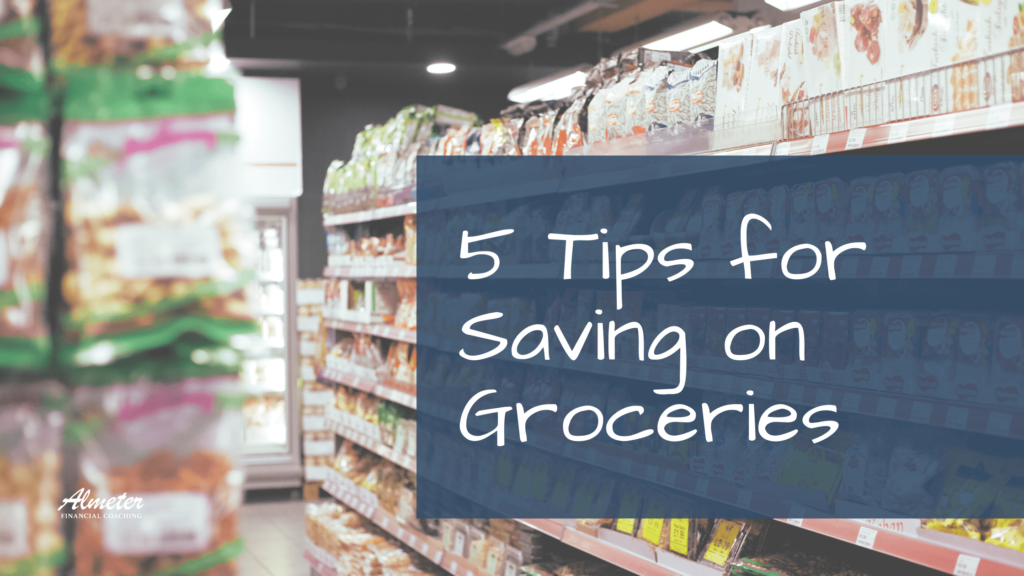Have you ever cashed out at the grocery store, saw your bill and wondered what the heck you just bought? Maybe the items didn’t see like a whole lot while they were in your shopping cart but your total owed told a different story. Groceries is one of our biggest monthly expenses. Here are 5 tips for saving on groceries.
1. Coupons
I am not a crazy coupon lady but I try to use them as much as I can. With online coupons like Coupons.com, it’s easier to find coupons for your favorite brands. Coupons.com has a variety of coupons that they update each month and the expiration date on them are typically a couple months out.
The trick to using coupons though is to only clip ones you are actually going to use. Don’t buy something just because you have a coupon for it. Only clip coupons for your favorite items or if it’s something new you want to try.
Did you know you can double up on coupons in one transaction?
You can use manufacturer and store coupons in one transaction. I do this mainly with BJ Wholesale coupons that come in their membership coupon booklet. The coupons in the booklet are “store” coupons and will have the store logo on it. Manufacturer coupons will typically say “manufacturer coupon” in the fine print. So for example, I can use a Pampers Diapers coupon from the BJ’s book and a Pampers coupon from Coupons.com in one transaction. The only time this doesn’t work is if both coupons are “manufacturer” coupons. Read the fine print of the coupon. Sometimes manufacturer coupons will have the store logo on them so they can only be redeemed in that store but you won’t be able to double up.
2. Store Brands vs. Name Brands
We all have our favorite brands for different items but a lot of time you are paying extra money just for the name on the package. Store brands are cheaper but are oftentimes similar to their brand name counterparts.
The best way to see if the store brands are to your liking is just to try them out. Some things you probably can’t even tell the difference. We did this with Oreos. My hubby got 2 bags of Wegman store brand “Oreos” for the same price as one bag of Oreos. The Wegman’s brand tasted just like Oreos! On the other hand, we decided to try the Tops “Oreos” to compare. The Tops brand was not as great.
Test different brands and see if you can find a new and cheaper favorite. This is also true for non-food products like soaps, paper products and medicine.
3. It’s All About the Shelf Space
Speaking of brand names and store brands, product shelf placement is also key to navigating the grocery store. The bigger brands work with the stores for prime shelf space; where it’s going to catch the customer’s eye the quickest. Since we naturally scan our eyes from left to right and top to bottom, bigger brands want their products at eye level. Your cheaper brands will be closer to the bottom.
Take notice of this next time you are at the store where there are several brands of the same product, such as pasta sauce or cereal. Generally the more expensive items will be at eye level and start to the left of the section and the cheaper items will be at the bottom right.
4. Make a Plan and Stick to Your List
The easiest way to let your grocery bill get out of hand is not being prepared. When you’re not sure what you want you will end up buying more than what you need. Before heading to the store, see what you already have in your house so you don’t buy something that’s already in the pantry. Then make a list.
Do your best to stick to that list and not get distracted by all the sales and impulse buys. This can be hard, I know. To make it a little easier on yourself don’t go to the grocery store hungry. When you are surrounded by food while you are hungry your stomach will be doing the talking and you will want to buy all the things!
5. Buyer Beware of Store Marketing
Not all advertised sales are the best deals. Sometimes the stores make it look like a great deal because they are trying to push a certain product. Let’s take a 10 for $10 sale for example. Do you really need 10 boxes of pasta? If you plan on stocking up and have the room in the budget, then go for it! But you don’t have to buy all 10 boxes of pasta to get the $1 each deal. If you only want 3 boxes then just get 3 boxes. They will still be $1 each.
Grocery store sales are very cyclical and if you pay close enough attention you will learn when your favorite brands are on sale. There’s a good change that the same pasta will go on sale again in about 4 weeks.
What tip did you find most helpful? Do you have any tips for saving on groceries? Share in comments below.

